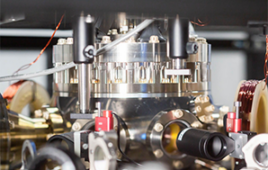Supercomputing: 3-D Blood Flow Model Predicts Heart Attacks
 |
| Left coronary arteries showing the ramification of vessels and the red blood cells flowing in one subregion. The longest coronary arteries have a size of few centimeters and the red blood cells have a linear size of about 10 microns. |
Researchers have designed a flowing 3-D model of the cardiovascular system that should allow for predictions of certain heart diseases before they become dangerous. They have recently developed a computer program that accurately models the complex system of blood flow in the heart for individuals at an unheard-of precision of 10 millionths of a meter, or 10 microns. These individual-specific models, which take up to six hours using the supercomputer Cadmos, installed at the Ecole Polytechnique Fédérale de Lausanne (EPFL), will allow for a detailed study of the cardiovascular system and lead to early predictions of heart conditions such as arteriosclerosis, or the hardening of arteries that often leads to heart attacks.
“When studying the blood flow in arteries, one has to take into account a vast number of different fluid interactions that happen on different time scales and of different sizes,” explains Simone Melchionna, of the EPFL Laboratory of Multiscale Modeling of Materials, who heads the project.
Based on a detailed heart scan, the simulation juggles over a billion different variables in order to represent a fluid containing 10-million red blood cells. Using another supercomputer based in Juelich (Germany), the research team has achieved even greater precision with their program that allows for the visualization of the interaction of plasma, red blood cells and even micro-particles.
“We can evaluate all of the elements and how they interact with each other; move, stagnate and whirl and turn over each other,” Melchionna adds.
This precision will allow for the detection of the first signs of arteriosclerosis when the plaques begin to form on the artery’s walls and disturb blood flow. This condition, which creates dangerous rigidity and blockage of these vital vessels, is the main cause of heart attacks — responsible for 12 percent of deaths in the world. This mortality rate increases to 16 percent in richer countries, where greasy and cholesterol rich foods are more common.
Plans are in the works to develop the program for individual PCs for clinical applications within the next two to three years.



